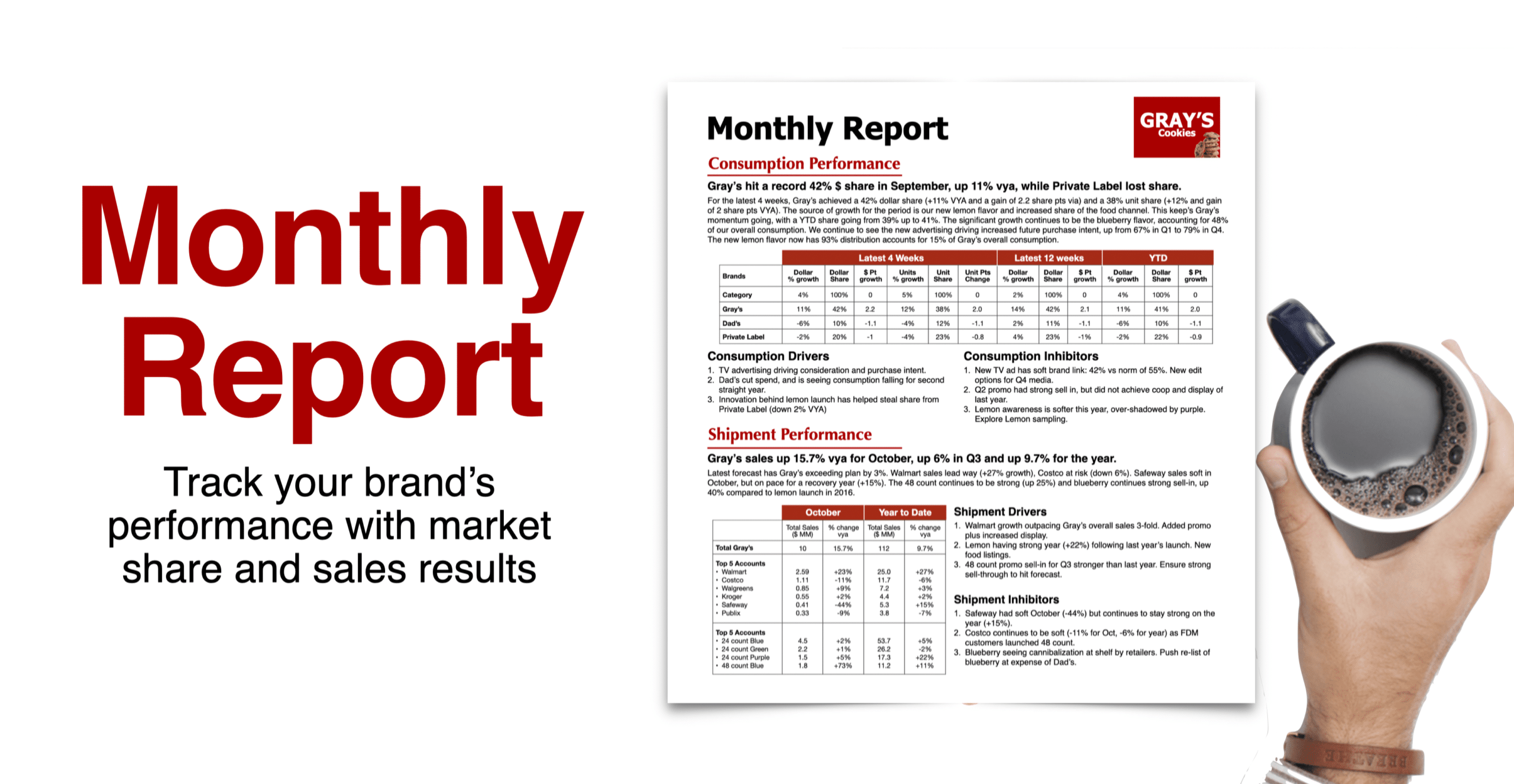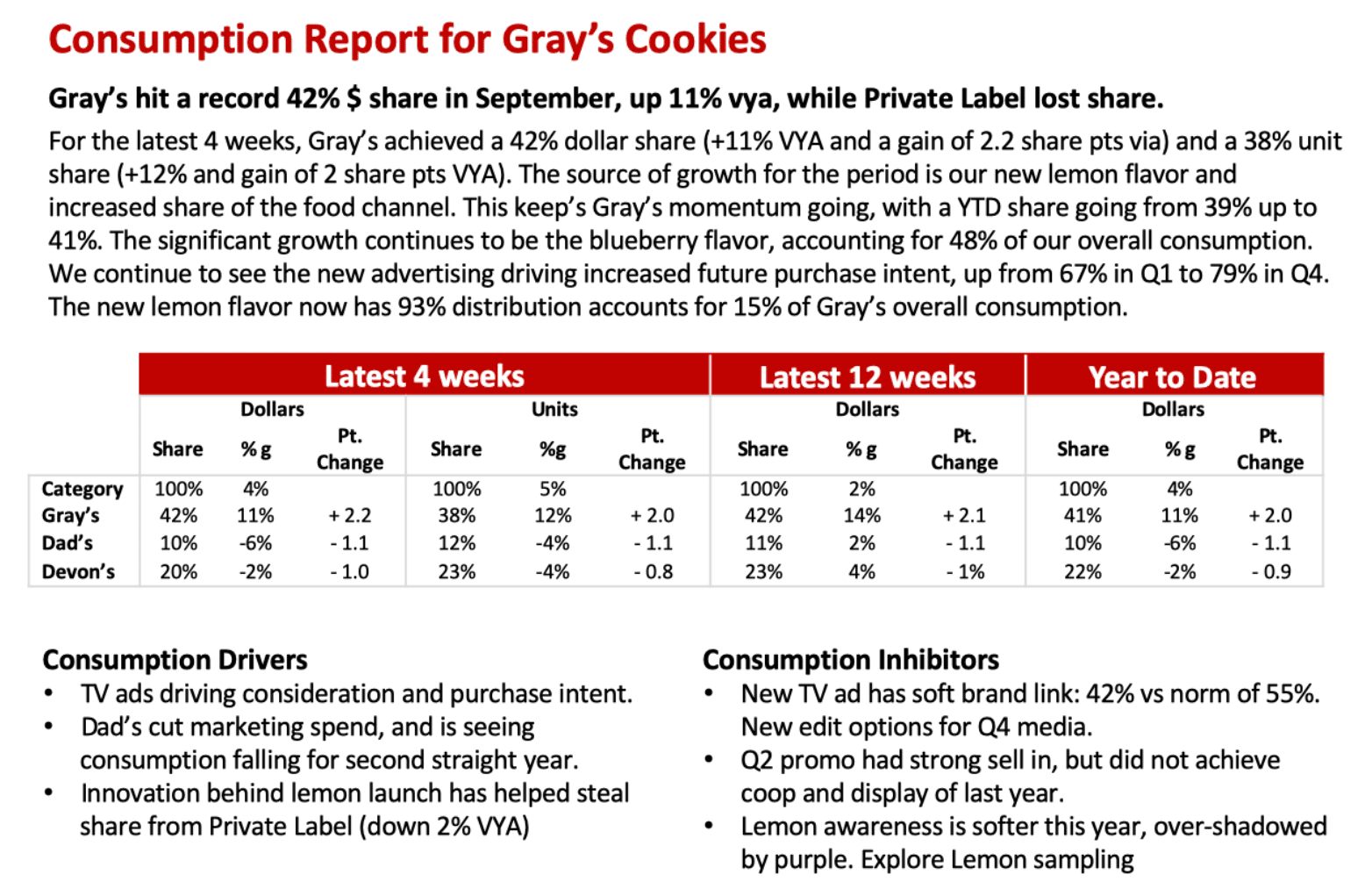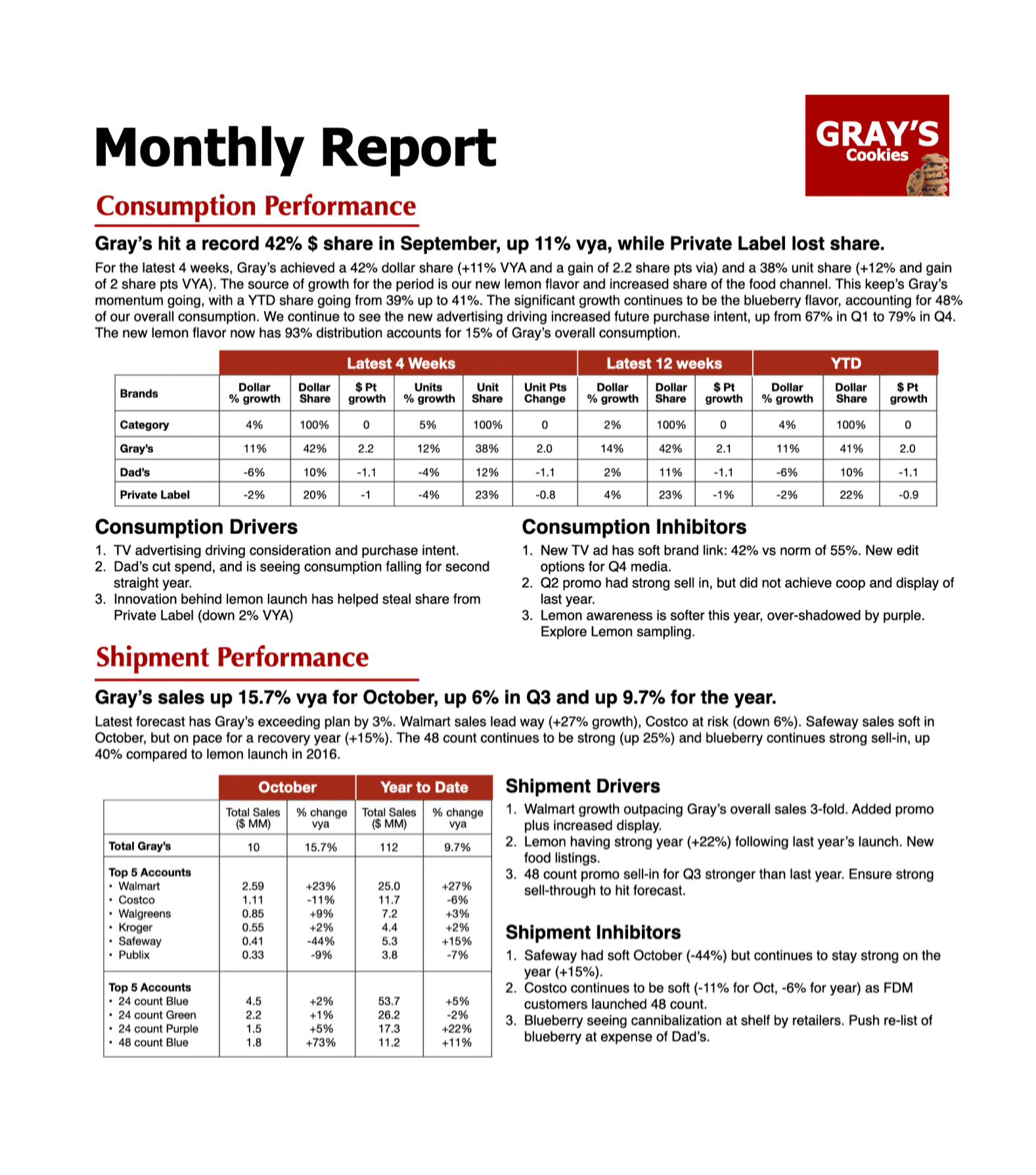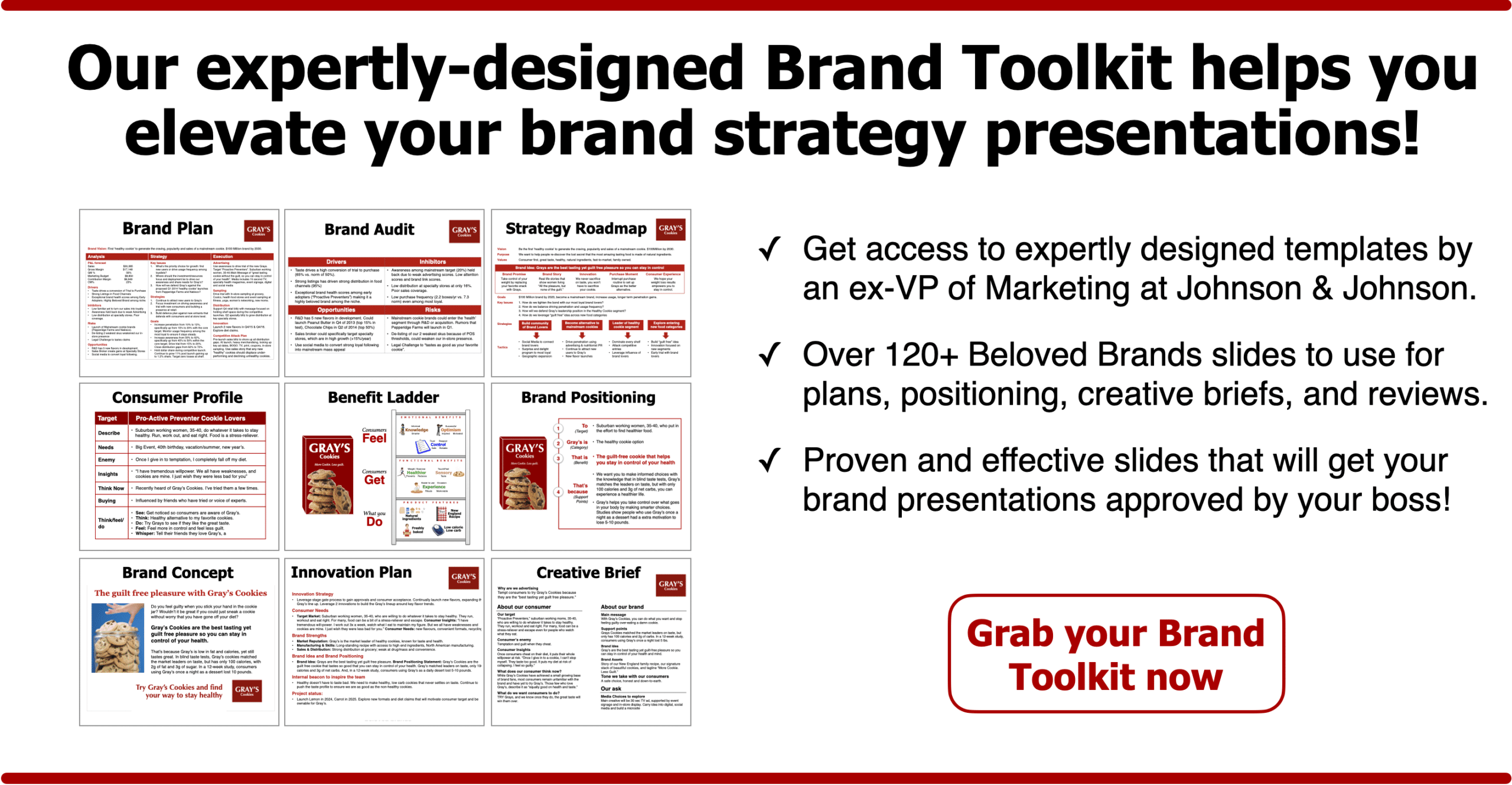In a world of big data and analytics, every brand should have a monthly report to track how the brand is doing through the course of the year. While these reports can feel tedious to write, the 3-4 hours it takes to dig in is a good investment in discipline, knowledge as well as maintaining that touch-feel of managing the brand.
The monthly report serves as a guide for everyone across the company to stay on track with the annual plan everyone is committed to delivering.
It gives senior management awareness of the grass-roots issues, enables course correction decisions at the senior levels, and exposes weakness and risk. It should carry action statements within the document that serve as a mini-version of the brand plan.
Finally, the monthly report gives everyone a sense that the brand team has full control of what’s happening in delivering the plan.
Table of Contents
Why have a Monthly Report?
The monthly report should answer the following CONSUMPTION questions:
What’s the one-line story that captures what’s happening on the brand? Think of the monthly report as your elevator speech for the CEO.
What’s the dollar, tonnage or unit share, on a 4-week, 12 -week and YTD basis? Focus on the share that the company uses–it can vary. Having all 3-time breaks allows people to see the trends.
How’s the brand doing vs year ago, prior periods, vs the category or vs plan for the year? Speak in terms of both % and share point changes. Theory of relativity allows you to tell the story better.
What’s the competition doing? Trends in the consumption, tracking results related to their brand funnel or potential action that’s rumored in the marketplace.
Drivers and inhibitors
What are the top 3 drivers of the brand for the month or year? It can be a combination of consumption trends (sku, regions, channel, account, flavor etc), beneath the surface Brand Funnel scores, program results that are contributing to share, competitive moves. Use the monthly report to explain how you’re going to continue these going forward.
What are the 3 inhibitors and what are you doing about it? These are things that are holding back the brand. Expose weaknesses you’re seeing in the programs, potential distribution gaps, competitive moves that are beating you, changes in consumer behavior etc. Explain what you plan to do about it, giving the assurance that you are running the brand.
Below is an example of the consumption section of our monthly report template.
The monthly report should answer the following SHIPMENT questions:
What’s the one-line story that captures what’s happening on the brand? The monthly report is the story that you know you could back up when confronted by the VP of sales in the same elevator. If it’s bad news, they must answer to the CEO.
What are the overall sales for the month and quarter, and how will they impact the year-end call? Based on that performance, senior management might adjust their own forecast or change their short-term investment stance.
How are the sales by key account, by skus or by regions? Track on both the month and on a YTD basis. This highlights the strengths and exposes weaknesses.
Drivers and inhibitors
What are the top 3 drivers of the brand for the month or year? You want to highlight the accounts, skus or regions that are showing the most growth, explain why and tell what you’re going to do to keep these going.
What are the 3 inhibitors and what are you doing about it? These are things that are holding back the brand. While the sales numbers are on the chart, start to explain the top line of what’s happening. Connect with the Account lead, ensuring they buy into the statement you’re about to put. This allows you to stay connected to what’s happening on each account.
If your account people aren’t great at getting back to you, saying “I’m about to write a monthly report for the President and I want to know what’s going on at your account”. They’ll get back to you. Also, you need answers in the monthly report to show that you are trying to get as much out of the brand as you can. Both short and long-term.
Below is an example of the sales section of our monthly report template.
Putting the Monthy Report together
As you are analyzing the mounds of data in front of you, you want to dig in everywhere that you can.
Start at the 4-week share for the brand overall, compare it to the 12-week, then the 52-week, and see the major trend. This is the start of the story for the monthly report. Dig deeper on regions, channels, and skus, figuring out the relative differences you start to see–either on the overall share basis (development index) or on the overall growth rate. Do the same with major competitors. That should give you the basis of your 4-week story and you can begin the document.
You next want to focus on the performance for the overall year.
With both consumption and share, you want to give management a good forecast on what you think will happen. This can be in consultation with sales and your demand teams. The story has to be consistently told and shared with the senior leaders. If they sense a disconnect, it will look bad on you.
If you have good tracking studies, dig in on program tracking (advertising, sampling, in-store, professional recommendations etc) any brand funnel tracking (awareness, trial, repeat, U&A) that can support what’s happening on the consumption and shipments.
Drivers and Inhibitors are things that are happening in the market, not things that could happen. Ideally, they should match up to the Annual Brand Plan and the objectives of the brand. Think of these monthly reports like 1/12th of your brand plan–not only highlighting how the brand is doing, but what you are willing to do about it.
Keep the monthly report on one page, forcing your writing style to be more direct. A senior leader should be able to digest it in 10 minutes.
Putting the monthly report together
To illustrate, click to zoom in for details.
As an Assistant Brand Manager, I dreaded doing the monthly report. It was a chore that cut into my life. It took all day to find the data—even all night. I always wondered if anyone would ever read my report. And I was awful on my first few attempts. I kept thinking that if I could get promoted to Brand Manager, I would no longer have to write a monthly report again. After a year, I became a master of the report.
When I got promoted, I re-wrote it for my boss.
And when I made it up to the VP Marketing level, I read everyone’s report in detail, even sending back inquiry questions for each of the 15 brands I had under me. I started to do my own version of the monthly report for the regional President.
I dug the same way I had at the junior levels and crafted the story. Not only did it project a sense of control over my business, but it also allowed me to sleep better because I knew what was going on with it. I was in control.
I always believe, "You run the brand. Don’t let the brand run you."
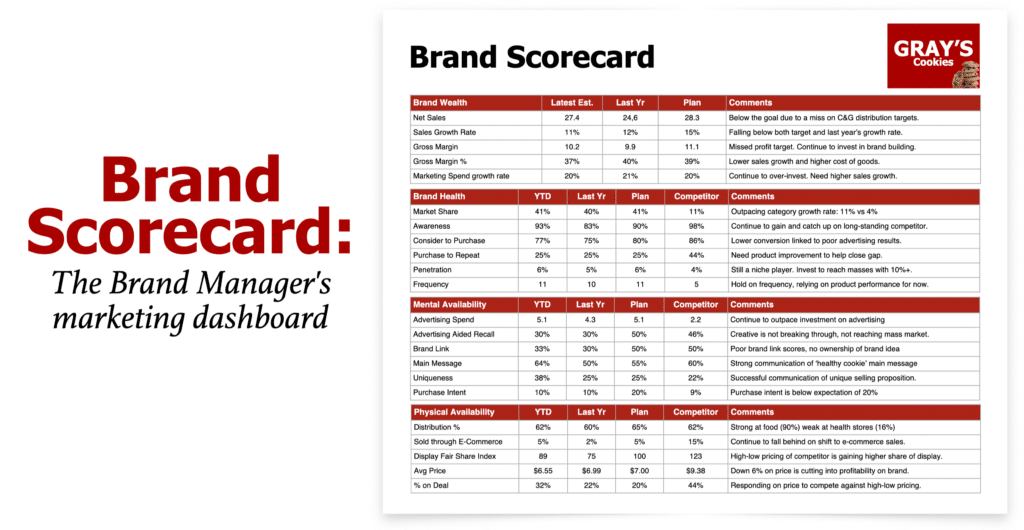
Video - Finding your key issues
Watch how to find the key issues on your brand that you can use in your marketing plan. If strategic thinkers see the right questions first, then you need to find the best possible questions before you can think about solutions.
To view, use the ▶️ controls to play or volume buttons
Conducting a SWOT analysis
A force field marketing analytics tool is best for brands in a sustaining position where marketing plays the role of driving innovation and creativity within a box. Always remember that Strengths & Drivers, and Weaknesses & Inhibitors are happening now. You can see the impact in the current year.
Anything in the future gets moved down to opportunities and threats that are not happening but could happen. People mix this up, and things that could happen move up when they shouldn’t.

Deep-dive Business Review template
The best thing about the force field marketing analytics tool is you can easily take it into an action plan because you want to keep the drivers going and overcome the inhibitors. Then, take advantage of the opportunities and minimize or eliminate any serious threats. It’s a great, simple management tool.

You can use our Business Review template, designed by an ex-VP Marketing.
- Expertly Guided Templates: Leverage examples and definitions on each slide, enabling you to communicate ideas and strategies with precision.
- Proven to Work: Unlike generic templates, ours are derived from years of experience and used by the best marketers to get their strategies approved.
- Tailored to your Business: While this Business Review is for consumer brands, explore our Business Reviews for retail brands, B2B brands, or healthcare brands.
- Save Time & Impress: Get the all-in-one Brand Consulting Toolkit with expertly designed presentation slides for consumer, B2B, healthcare, and retailer brands.
- Limited Offer: Originally $99.99, now just $79.99! Unbeatable value for top-tier content. For a further discount, use our 10% discount code: beloved
Beloved Brands Marketing Training
Our Beloved Brands Marketing Training program will make your team smarter.
If you are running a marketing team, you will always benefit from having a smarter team. When you invest in our marketing training program, you will help your team gain the marketing skills they need to succeed. As a result, you will see them make smarter decisions and produce exceptional work that drives business growth.
We’ll work with your team to help them learn more about the five core marketing skills: Strategic Thinking, Brand Positioning, Marketing Planning, Marketing Execution, and Brand Analytics. Most importantly, your marketers will learn new tools, concepts, and ideas to trigger new thinking. To help their skills, we get participants to take each tool on a test run. Then, we give feedback for them to keep improving.
Take a look at our Marketing Skills assessment tool to see how you or your marketing team measure up.
For more information on our Beloved Brands Marketing Training programs, click below or email Graham Robertson at [email protected]


